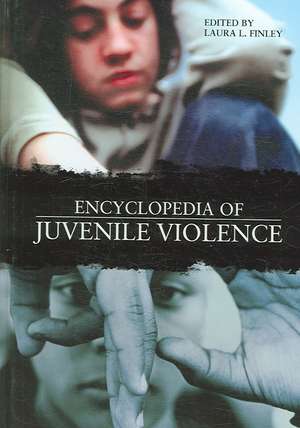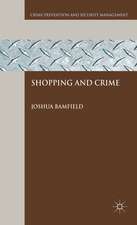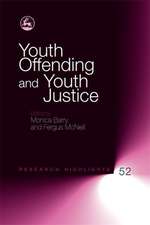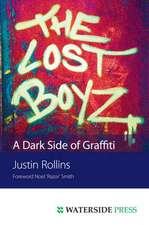Encyclopedia of Juvenile Violence
Editat de Laura L. Finleyen Limba Engleză Hardback – 29 dec 2006 – vârsta până la 17 ani
Preț: 372.16 lei
Preț vechi: 642.09 lei
-42% Nou
Puncte Express: 558
Preț estimativ în valută:
71.22€ • 76.15$ • 59.38£
71.22€ • 76.15$ • 59.38£
Carte tipărită la comandă
Livrare economică 17 aprilie-01 mai
Preluare comenzi: 021 569.72.76
Specificații
ISBN-13: 9780313336829
ISBN-10: 0313336822
Pagini: 360
Dimensiuni: 178 x 254 x 27 mm
Greutate: 0.89 kg
Ediția:New.
Editura: Bloomsbury Publishing
Colecția Greenwood
Locul publicării:New York, United States
ISBN-10: 0313336822
Pagini: 360
Dimensiuni: 178 x 254 x 27 mm
Greutate: 0.89 kg
Ediția:New.
Editura: Bloomsbury Publishing
Colecția Greenwood
Locul publicării:New York, United States
Notă biografică
Laura L. Finley is currently a Visiting Professor of Sociology at Florida Atlantic University. She is also Manager of the Training Department at Women In Distress, an agency devoted to ending domestic abuse. She is co-author of Piss Off! How drug Testing and Other Privacy Violations are Alienating America's Youth. Another co-authored book, The sport Industry's War on Athletes, will be published in fall 2006.
Recenzii
Finley has compiled a one-volume encyclopedia of essays related to juvenile violence. The signed articles are written by a wide range of academics, practitioners, and students on topics such as drugs, gangs, the justice system, measurement of juvenile violence, school violence, and theories about the reasons for juvenile violence. One notable section presents a series of articles, focused on historical time periods, which show how approaches to juvenile violence have changed dramatically over the years. For example, the essay on the period 1600-1800 notes that children were expected to assume adult culpability for crimes they committed. In contrast, the years 1990-99 showed an all-time high for juvenile violence, followed by a rapid decline at the end of the decade (for various reasons). A list of pertinent Web sites and readings is included. No exactly comparable reference works are available..Recommended. Lower-level undergraduates through graduate students; general readers.
To date this is the only ready-reference source soley devoted to the topic of juvenile violence, making it useful in academic, public, and high school libraries.
This book will be most useful for an entry-level student who wishes to become a professional assistant with law enforcement with juveniles..For parents who are not aware of the dimensions of possible youth problems in their schools and neighborhoods, this encyclopedia will provide a mine of information about the extent of the problem..This volume is best used as a resource for facts and statistics on the prevalence of youth crimes and on the variety of agencies and laws that have arisen to address such violence.
This volume is a clear, concise attempt at defining a complex and disturbing subject. A Chronology of Key Events from 1642 to 2005 gives readers an excellent frame of reference for the development of the phenomenon over time. Contributors come from the fields of sociology, psychology, education, history, social work, political science, policing, and education. The alphabetically arranged, one- to three-page selections give enough information to spur research on just about any aspect of child and adolescent violence. Some articles discuss theories, while others give accounts of infamous individuals, pivotal court cases, or descriptions of extreme incidents. Each one is followed by a further-reading list that has print resources and, occasionally, Web sites. There is no reference book in print that covers the topic in as much detail as this work..[t]he book is readable and useful in whole, or in part.
This work is recommended for use at undergraduate/specialist reader level to provide an overview of the complex social field of juvenile violence. With no other comparative work at this level in terms of spectrum and currency, its merits lie in the collation of perspectives from many different fields and bringing these together in a volume that is up-to-date, well balanced and informative.
From Abused/Battered Children to Zero Tolerance Laws, the 270 alphabetical entries presented by Finley in this reference provide information on the frequency and types of juvenile violence in the United States, as well as historical information, assessment of relevant theories, examination of media issues, discussion of measures of juvenile violence, and examination of social and criminal responses to juvenile violence. Other representative examples of entry topics include the Boston Youth Strike Force, the Central Park Jogger case, curfews, delinquency and drift theory, theories on gang involvement, frequency of perpetration of violence by gender, genetic theories, types of gun-related violence, history of juvenile violence (by decade), marijuana, restorative justice, situational crime prevention, teen courts, and urban juvenile violence. Each entry provides a guide to further reading.
To date this is the only ready-reference source soley devoted to the topic of juvenile violence, making it useful in academic, public, and high school libraries.
This book will be most useful for an entry-level student who wishes to become a professional assistant with law enforcement with juveniles..For parents who are not aware of the dimensions of possible youth problems in their schools and neighborhoods, this encyclopedia will provide a mine of information about the extent of the problem..This volume is best used as a resource for facts and statistics on the prevalence of youth crimes and on the variety of agencies and laws that have arisen to address such violence.
This volume is a clear, concise attempt at defining a complex and disturbing subject. A Chronology of Key Events from 1642 to 2005 gives readers an excellent frame of reference for the development of the phenomenon over time. Contributors come from the fields of sociology, psychology, education, history, social work, political science, policing, and education. The alphabetically arranged, one- to three-page selections give enough information to spur research on just about any aspect of child and adolescent violence. Some articles discuss theories, while others give accounts of infamous individuals, pivotal court cases, or descriptions of extreme incidents. Each one is followed by a further-reading list that has print resources and, occasionally, Web sites. There is no reference book in print that covers the topic in as much detail as this work..[t]he book is readable and useful in whole, or in part.
This work is recommended for use at undergraduate/specialist reader level to provide an overview of the complex social field of juvenile violence. With no other comparative work at this level in terms of spectrum and currency, its merits lie in the collation of perspectives from many different fields and bringing these together in a volume that is up-to-date, well balanced and informative.
From Abused/Battered Children to Zero Tolerance Laws, the 270 alphabetical entries presented by Finley in this reference provide information on the frequency and types of juvenile violence in the United States, as well as historical information, assessment of relevant theories, examination of media issues, discussion of measures of juvenile violence, and examination of social and criminal responses to juvenile violence. Other representative examples of entry topics include the Boston Youth Strike Force, the Central Park Jogger case, curfews, delinquency and drift theory, theories on gang involvement, frequency of perpetration of violence by gender, genetic theories, types of gun-related violence, history of juvenile violence (by decade), marijuana, restorative justice, situational crime prevention, teen courts, and urban juvenile violence. Each entry provides a guide to further reading.













